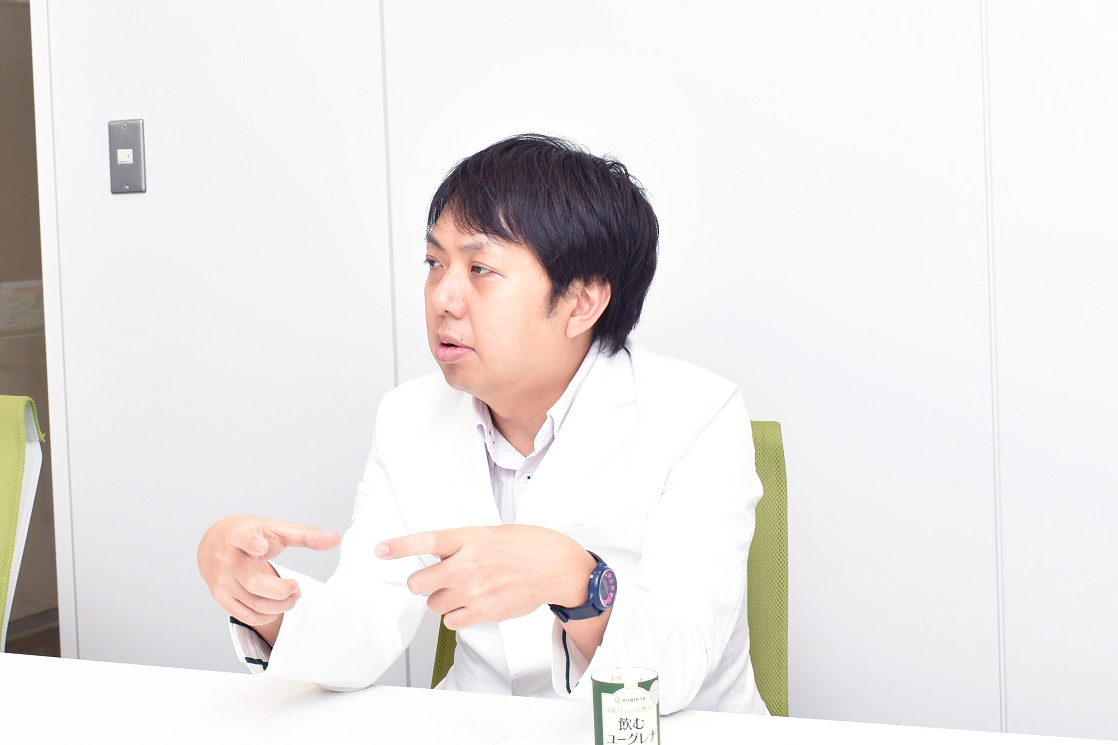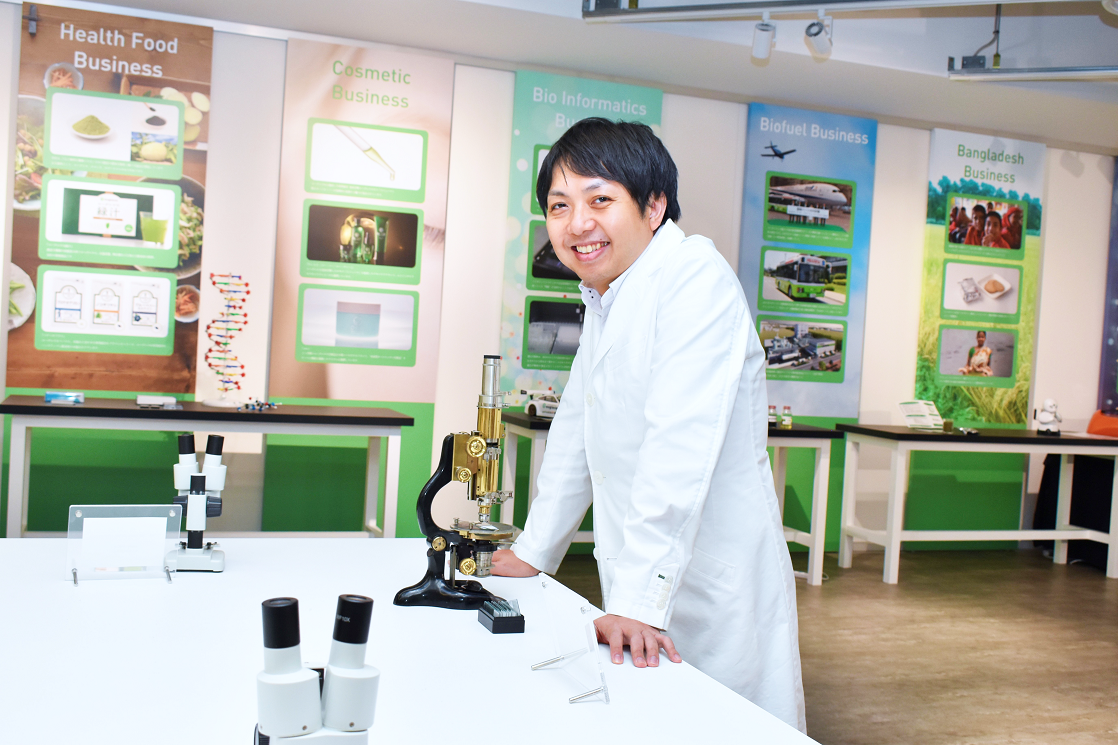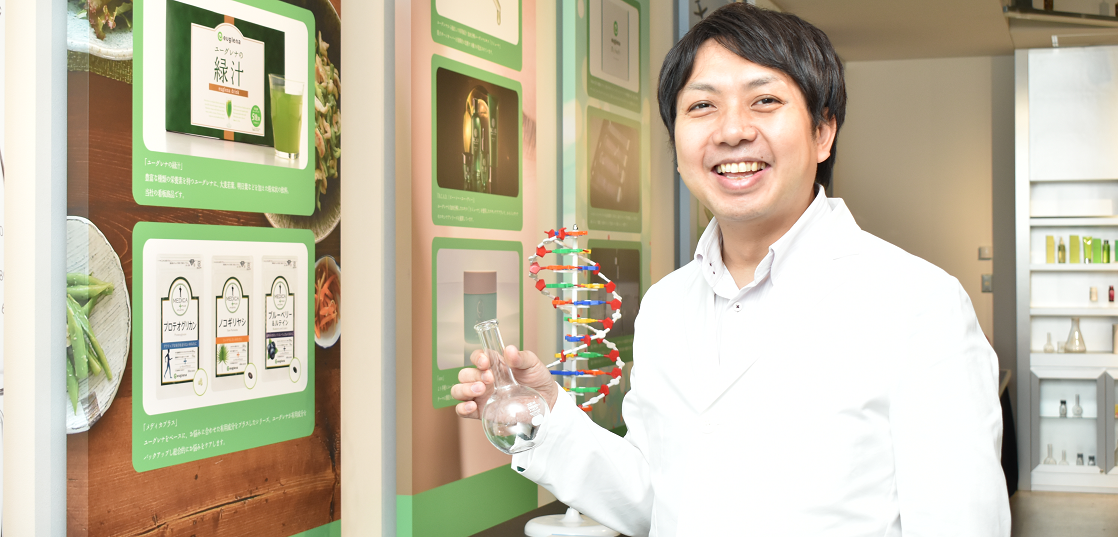Various bacteria that support Japanese food culture
-I heard that you are conducting research on fermentation by microorganisms.
Kengo Suzuki (hereinafter referred to as Suzuki):is that so. Originally, Euglena but in recent years, we are also conducting research on microorganisms that are decomposers and fermentation by microorganisms.
-Can you tell us about the decomposer again?
Suzuki: In the ecosystem, there is a way of thinking that organisms are divided into three categories: producers, consumers, and decomposers. Producers are those who produce organic matter from inorganic matter, such as plants. Euglena microalgae, is also a producer that synthesizes organic matter from carbon dioxide, water, and sunlight. Consumers are the ones who consume the organic matter produced by the producer and circulate the organic matter, such as animals. Of course, humans are also consumers. Decomposers play a role in decomposing organic matter into inorganic matter, such as bacteria.
It is thought that the ecosystem circulates due to the existence of these three "producers, consumers, and decomposers."
-I don't usually think about bacteria very much, but they play an important role.
Suzuki: Various bacteria are used in our familiar products. For example, soy sauce and miso use Jiuqu, and natto uses natto. It can be said that various bacteria support Japanese food culture.
-Soy sauce, miso, natto, and so on, are all familiar to us.
Suzuki: Historically, it is believed that the food culture that utilizes bacteria came from China. It seems that vinegar has been produced in China using rice and aspergillus since BC. Since then, food cultures that utilize various bacteria have developed in various parts of Japan. For example, Funazushi in Shiga Prefecture uses lactic acid bacteria. It is interesting that various bacteria and fermentation methods have developed depending on the region.
-You have so much history.
Suzuki:I agree. Furthermore, food culture that utilizes bacteria can be found all over the world. Cheese and yogurt have been produced in Europe for a long time, and alcohol is produced all over the world using various raw materials.
-Is alcohol also utilizing bacteria?
Suzuki: There are differences in raw materials and production methods, but the common point is that they are fermented using bacteria. Among them, sake is made using two or more types of bacteria and symbolizes the culture of Japanese bacteria utilization.
-Two or more types of bacteria. Is it usually one type?
Suzuki: Wine is made by fermenting the sugar content of grapes with yeast, and I think it is common to ferment other alcohols with one type of fungus. On the other hand, in sake, aspergillus is first used to break down rice into sugar, and lactic acid bacteria based on yeast are sometimes used to make sake mothers to promote fermentation.
The delicate and diverse flavor of sake comes from the use of such bacteria.
-You can feel the depth of sake.
Suzuki:I agree. Personally, I support a sake brewery called Tsunan Brewery in Niigata Prefecture because I want to support the appeal of sake. We would like to protect and develop the culture of sake and the utilization of bacteria related to sake production.

Kengo Suzuki Kengo Suzuki (Euglena Executive Officer in charge of research and development)
Graduated from the University of Tokyo, Faculty of Agriculture, majored in biological system engineering, founded Euglena Co., Ltd. in August 2005, and became a director and general manager of the R&D Department. In December of the same year, we succeeded in the world's first large-scale cultivation of the world's first edible outdoor mass culture of microalgae Euglena (Japanese name: Astragalus). In 2016, he received a doctorate in agriculture from the University of Tokyo. In 2019, he received a doctorate in medicine from Kitasato University Graduate School. While engaged in research on the utilization of microalgae Euglena and other algae, he is also engaged in research aimed at the development of biofuel production derived from Euglena.
Euglena and fungus mariage
―I heard that Euglena activates the activity of the fungus.
Suzuki: According to the research conducted by our company, Euglena was added improved the amount of various degrading enzymes compared to the aspergillus group to which it was not added. In other words, Euglena became a nutrient and activated Jiuqu.
Based on these research results, we also develop and sell a product (green koji) that combines Euglena
-Midori Jiuqu is a health food, but what kind of person is it suitable for?
Suzuki: Euglena contains 59 kinds of abundant nutrients and is expected to be a nutrient for various bacteria including Jiuqu. In recent years, the idea of symbiotics, which is a combination of probiotics that ingest live bacteria and prebiotics that ingest the food of intestinal bacteria, has attracted attention, and Midori Koji has also been developed with reference to such an idea. increase.
Since Midori Jiuqu contains live Jiuqu, it can be ingested, and Euglena activates intestinal bacteria by nourishing various bacteria such as lactic acid bacteria in the intestine, which contributes to the intestinal environment and immunity. May work. I would like people who are concerned about the balance of the intestinal environment to try it.
Euglena activates bacteria, it seems that there are various possibilities other than health foods.
Suzuki:is that so. In addition to foods and health foods, fermentation using bacteria is carried out in various situations, so I think there is a possibility of using Euglena
Achieve a sustainable circulation environment with Euglena
-Mr. Suzuki is also conducting research on the living environment of space.
Suzuki: Actually, research on bacteria is linked to research on the living environment of the universe. Life in space such as the moon, Mars, and artificial satellites is supposed to live in a closed environment with poor ecosystems.
As I mentioned earlier, the Earth has diverse ecosystems and many "producers, consumers, decomposers", but the universe (at least the environment of the stars of the solar system where humans are supposed to live). Then) does not have such an ecosystem. Currently, food and oxygen are brought in from the earth, and human domestic wastewater often reuses the water part but discards the remaining components, but when assuming a long-term stay. , I think it is necessary to realize a sustainable circulation environment in space.
In other words, we are wondering if we can realize a circulating environment that includes humans by bringing microalgae such as Euglena, which is the producer, and bacteria, which are the decomposers, into the living environment of space.
-You bring Euglena and the fungus to space.
Suzuki: Specifically, we bring in 400 liters of water and Euglena, and cultivate them using sunlight and carbon dioxide and ammonia emitted from human life. If the environment is set up, Euglena will increase about twice a day, so we estimate that we can provide nutrition for one day for humans. Cultured Euglena microalgae, such as eating human, a domestic wastewater emanating from human Euglena bacteria such as carbon dioxide and ammonia, which can be utilized for the cultivation of will assume the circulation that decomposition.
-Do you mean to realize the miniature size of the earth's ecosystem in space?
Suzuki:is that so. In the closed environment of the universe, it is important how to efficiently circulate such ecosystems. From that point of view, we believe that microalgae such as Euglena, which are rich in nutrients and have excellent culture efficiency, are promising producers. Currently, we are also conducting research on bacteria that are decomposers, and we would like to realize a sustainable circulation environment in space.

Euglena and fungi that also contribute to global environmental problems
-Realize a sustainable circulation environment in space. I have a dream.
Suzuki: We believe that we can contribute not only to utilization in space but also to global environmental problems. For example, if the waste that has been incinerated so far can be mineralized by utilizing bacteria, it will be possible to reduce the emission of carbon dioxide that accompanies incineration. At present, it seems that the mineralization using bacteria has not spread sufficiently from the viewpoint of efficiency, but there is a possibility that more efficient mineralization can be realized by activating the bacteria by Euglena
In other words, Euglena has the potential to absorb carbon dioxide as a producer, activate decomposers such as bacteria, and increase the efficiency of mineralization.
―The research on Euglena and the research on the activation of bacteria will contribute to the living environment of the universe and the environmental problems of the earth.
Suzuki:is that so. I would like to continue to focus on these studies. Euglena progresses, it will be possible to contribute to health problems, living environment in space, and environmental problems of the Our management philosophy of "making people and the earth healthy". I think it will contribute.
-Personally, I'm also interested in using it in sake.
Suzuki: There is a possibility that the use of Euglena Personally, I think it is very important to enrich the Japanese food culture, so I would like to work on making delicious sake and making effective use of by-products such as sake lees.

* Honorific titles omitted in the text
Photo: Naoko Saegusa

